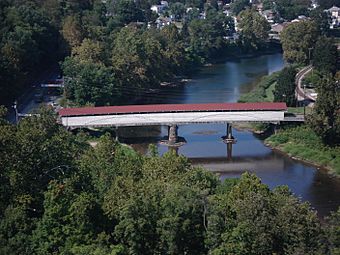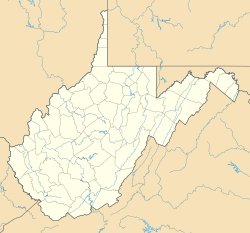Philippi Covered Bridge facts for kids
Quick facts for kids |
|
|
Philippi Covered Bridge
|
|

Philippi Covered Bridge (1852) spanning the Tygart Valley River at Philippi, West Virginia, as it appears since its 1991 reconstruction. The neighborhood of North Philippi is visible beyond
|
|
| Location | U.S. 250 at jct. with U.S. 119, Philippi, West Virginia |
|---|---|
| Area | less than one acre |
| Built | 1852 |
| Architect | Chenoweth, Lemuel |
| MPS | West Virginia Covered Bridges TR |
| NRHP reference No. | 72001284 |
| Added to NRHP | September 14, 1972 |
The Philippi Covered Bridge is a famous landmark in Philippi, West Virginia, USA. It crosses the Tygart Valley River. This bridge is a very important part of local history.
The General Assembly of Virginia asked for this bridge to be built. It was finished in 1852 by Lemuel Chenoweth, a famous bridge builder. The bridge was a key part of the Beverly-Fairmont Turnpike. This road connected Beverly and Fairmont. The bridge is also famous for its role in the American Civil War, especially the Battle of Philippi in 1861.
The Philippi Covered Bridge is the oldest and longest covered bridge in West Virginia. It is one of only two covered bridges left in Barbour County. It is also the only covered bridge used by the US Federal Highway system (U.S. Route 250). The bridge was added to the National Register of Historic Places in 1972.
Contents
Bridge History
Building the Bridge
The Philippi Covered Bridge was designed by Lemuel Chenoweth. He was known for building strong bridges. His design was chosen after a special competition. Many builders showed off their bridge models. Chenoweth's model was made of hickory wood. He showed how strong it was by standing on it. None of the other builders dared to stand on their own models. Because of this test, Chenoweth won the contract to build the bridge.
The bridge is about 285 feet long and 26 feet wide. It was first supported by three large stone piers. These piers were built by Emmett J. O'Brien. The bridge uses a special design called the "Long" Burr Arch Truss. It cost about $12,180 to build. It is one of the few "double-barreled" (two-lane) covered bridges still standing in the United States.
The Civil War Connection
The bridge played a role in the American Civil War. On June 3, 1861, both Union and Confederate soldiers used it. This was after the Battle of Philippi. Many people consider this the first land battle of the Civil War. The bridge was the first one captured in the war. The winning Union troops even used it as a place to sleep for a while.
The bridge was almost burned down in 1863. This happened during Confederate attacks on the B&O Railroad. General William E. Jones ordered it to be burned. However, some local people who supported the South helped save it. One of them was Elder Joshua S. Corder.
Changes Over Time
The Philippi Covered Bridge has been repaired many times. It has been badly damaged at least seven times over the years.
In 1934, more cars started using the bridge. So, two new concrete piers were added to support it. This made a total of five piers. A new concrete deck replaced the old wooden one. An outside walkway was also added for people walking.
The bridge was heavily damaged by a big flood in 1985. Then, in 1989, it was almost completely destroyed by fire. This fire started when gasoline spilled from a tanker truck nearby. A car passing through the bridge then caused a spark, setting it on fire.
The bridge was closed for repairs. A big reconstruction project costing $1.4 million was completed. The bridge reopened on September 16, 1991. During this work, damaged parts were replaced. The outside of the bridge was made to look just like it did originally. The rounded entrances were fixed. Red shingles were put on the roof. New wooden siding was also added.
Today, you can still see some of the original, burnt wooden parts when you drive through the bridge.
Folklore
- A local story says that US President Abraham Lincoln and Confederate President Jefferson Davis met secretly in the bridge. A small boy supposedly saw them. They were said to be discussing peace during the Civil War.
Images for kids






